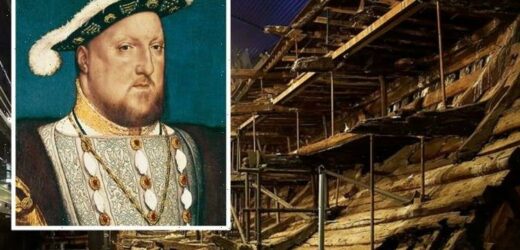GMB: Rishi Sunak and Adil Ray clash during interview
We use your sign-up to provide content in ways you’ve consented to and to improve our understanding of you. This may include adverts from us and 3rd parties based on our understanding. You can unsubscribe at any time. More info
Tiny, acidic specks of iron and sulphur compounds are breaking down the ship and urgently need to be removed to preserve the 510-year-old vessel. The famous four-masted, carrack-type vessel was salvaged in 1982 after spending four centuries on the Solent seabed, off the coast of the Isle of Wight. The ship was sunk there on July 19, 1545, in a battle against a French fleet. Recovery of the warship gave valuable insights into Tudor society as it uncovered artefacts like weapons, sailing equipment and the crew’s possessions.
But when the shipwreck was lifted out of the water, exposure to oxygen in the atmosphere resulted in the formation of acidic, sulphur-based compounds that are breaking down the wood of the hull.
Now, a new study led by the University of Sheffield took samples from the Mary Rose that were analysed using X-ray computed tomography.
The scans unveiled previously undetected nanoparticles that were slowly destroying the wood of the ship.
The work was carried out at the European Synchrotron Radiation Facility, which is a particle accelerator in Grenoble in France.
The site has the brightest X-ray in the world and can function as a super-powered microscope.


Researchers have said that the findings will be used to develop new techniques to remove the tiny specks savaging the Tudor vessel’s remains.
Currently, the remains are on display at the Mary Rose Museum in Portsmouth Historic Dockyard.
Study paper author and functional nanomaterials expert Serena Cussen, from the University of Sheffield, said: “It is remarkable that this technique at the ESRF allows us not only to image and locate these nanoparticles in Mary Rose wood, but also to evaluate their structure.
“This is the first time zinc sulphide nanostructures — the bacterial by-products — have been observed in Mary Rose wood.”
She added: “Up to now, it has not been possible to obtain quantitative structural information about the nature of these potentially harmful species.

“This is because it is really challenging to assess the range of materials present within archaeological samples, which can include amorphous, nanostructured, and polycrystalline materials.”
Historians believe that the vessel sank during a battle against French invaders.
The ship is thought to have served for 33 years and had been extensively modified over time.
Researchers think that because so much additional weight from extra cannons was added, the ship became unstable.
The theory is that when the sailor of the vessel pulled off a turn it got caught in a gust of wind and tilted, allowing water seep into the gunports and sink it.
The warship became buried in silt on the seabed which luckily preserved around 40 percent of the hull.
DON’T MISS
EU cracks deepen as four countries join Spain’s energy revolt [INSIGHT]
AstraZeneca and Pfizer jabs linked with new side effect [REVEAL]
Archaeology: Nazi U-boat wreck ‘beats Tutankhamun’ [REPORT]


Anaerobic bacteria, release a compound called hydrogen sulphide, then took hold of the sunken vessel.
The substance is harmless, but when it is exposed to oxygen corrosive sulphuric acid and sulphate salts form.
Making it worse is all the iron on board the ship, with nails, bolts, and cannons catalysing the acid production.
Conservators have put a special polymer called polyethene glycol in the ship’s hull.
This gives mechanical stability to the wrecked ship while also helping to stop the wood from shrinking as it was dried out.
Luckily, the researchers have been able to map out the location of potentially harmfully compounds in samples of wood by combining X-ray scan data with pair distribution function analysis, which provides structural information on disorder materials.
Source: Read Full Article


